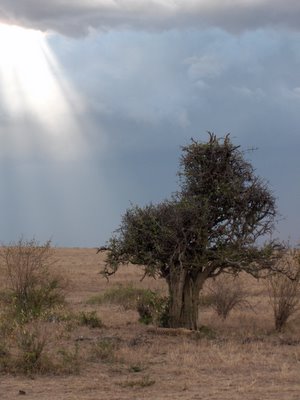
Saturday, 31 December 2005
Kenya's Sunrises and Sunsets

Wednesday, 28 December 2005
Bad Monkey!

 M & J: Ah, primates... our closest relations. Vervet monkeys, baboons, syke monkeys, you name them, they were everywhere!
M & J: Ah, primates... our closest relations. Vervet monkeys, baboons, syke monkeys, you name them, they were everywhere!Here are some "primal" (sorry) memories from our trip:
At the Samburu National Reserve, camp site refuse was tossed into a large pit and subsequently burned. This may not sound terribly interesting (nor terribly eco-friendly), but the scenes that ensued were. In fact, we felt like we had stumbled onto the set of Space Odyssey 2001: a small platoon of baboons -- from geezers to young'uns -- had circled around the fire, greedily grabbing whatever they could salvage, and bellowing out shrieks and cries every time the hot flames surprised them. Talk about an absence of Pavlovian instinct.
At the same park, we witnessed a young vervet monkey getting a "right lickin'" from his dad for horsing around too much. As a Canadian, John thought about giving the dad a lecture on the futility of corporal punishment, but eventually decided against it.
John also exchanged some words with a few sneaky monkeys in Masai Mara, who not only had the audacity to break into our tent and steal our peanuts and popcorn, but were cocky enough to discard the empty popcorn bag on our tent floor. Bah!
Tuesday, 27 December 2005
Satisfied Kitty
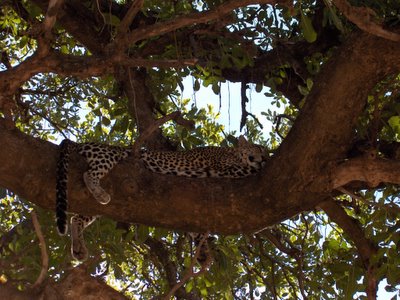 J & M: On one of our safari game drives in Samburu Natural Reserve, we came across a leopard in a tree snacking on a baby impala. Since the leopard is one of the most reclusive animals in Africa, we were extremely lucky to catch a glipse.
J & M: On one of our safari game drives in Samburu Natural Reserve, we came across a leopard in a tree snacking on a baby impala. Since the leopard is one of the most reclusive animals in Africa, we were extremely lucky to catch a glipse.But we were not the only ones enjoying this spotting: about 20 other safari groups were sharing the experience with us. Safari vans jousted for the best viewing position. The best viewing position was hogged by a peculiar photographer with the world's most powerful camera lens (this thing was a a meter long). He was the same guy we had seen hanging around with his monster camera and nothing but his tight Euro-speedo the day earlier, patiently waiting to snap close-ups of tiny birds drinking from a leaky water pipe.
The photo above was taken once the leopard had stuffed his little belly and washed up. You would have never known this cute guy was capable of causing such carnage. :) For more pics, click here.
Monday, 26 December 2005
Visit to a Masai village
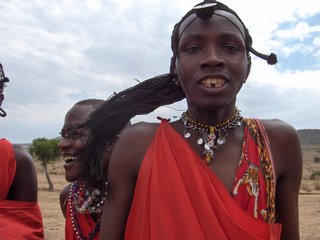 J&M: We started our safari adventure in Masai Mara. The park conjures up all the glorious images you would expect of the African plains.
J&M: We started our safari adventure in Masai Mara. The park conjures up all the glorious images you would expect of the African plains.On day two we carried out our requisite tourist duties by visiting a Masai village. Before entering the enclosed village, we were given a welcome dance, which JK was subsequently invited to join. The dance entailed a lot of jumping. Let's just say the NBA won't be recruiting JK any time soon.
After an interesting tour (by a very charming Masai warrior) of the inside of a typical Masai home, JK was invited to make fire by rubbing two "special" sticks rapidly over flammable (and relatively scentless, if you're that curious) elephant dung. Despite utterly failing to create any heat, let alone fire, JK was convinced to purchase the two sticks for an...ahemm...mere $20 (you know, just in case we end up on an isolated island with no possessions but the two special sticks).
I must say these young Masai guys had finally honed sales skills. I can only imagine how many encyclopedia sets or vacuum cleaners they could sell in Canada. They also convinced John, by shamelessly playing on his machismo :), to buy one of their special warrior clubs. They insisted every man should have one. John concurred...
Anyway, it was an amusing adventure. For more pics, click here.
Sunday, 25 December 2005
Saturday, 24 December 2005
Thursday, 22 December 2005
Chimp Island
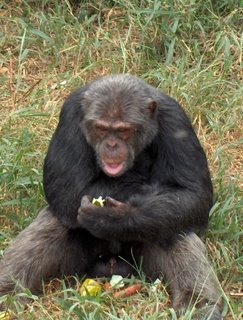 M: My last adventure before leaving Uganda was a visit to the Ngamba Island Chimpanzee Sanctuary on Lake Victoria. This "sanctuary" is a whole island containing chimps! Let's hope they don't learn how to make boats because we could be looking at a real-life "Planet of the Apes"!
M: My last adventure before leaving Uganda was a visit to the Ngamba Island Chimpanzee Sanctuary on Lake Victoria. This "sanctuary" is a whole island containing chimps! Let's hope they don't learn how to make boats because we could be looking at a real-life "Planet of the Apes"!Saturday, 10 December 2005
Trip to Northern Uganda - Gulu
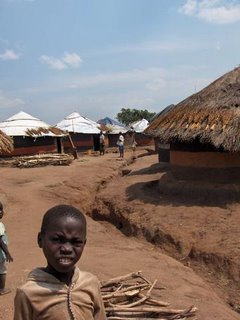 M: With much distress, I boarded the same small Eagle Air LET-410 on Wednesday the 7th of December and made the twenty-minute flight to Gulu (a district southwest of Kitgum).
M: With much distress, I boarded the same small Eagle Air LET-410 on Wednesday the 7th of December and made the twenty-minute flight to Gulu (a district southwest of Kitgum).To see more photos of Gulu, click on the photo above and you will be automatically directed to the album. Post a comment and let us know what you think!
Trip to Northern Uganda - Kitgum
M: I landed in Kitgum about an hour and fifteen minutes after leaving Entebbe. [Kitgum is one of the northern districts which borders Sudan. Within it, is Kitgum town, which is pretty small.] I was so shaken up by the flight that I completely forgot about my luggage, only to remember it once the plane had already started up again and was ready to take off! Luckily, the plane routed back to Kitgum forty minutes later so I was able to retrieve it then. The remainder of the day was spent visiting UNICEF and UNOCHA.
The Bomah Hotel was definitely not worth the 30,000 Uganda Shillings I paid (about US$17). The mosquito net had several large holes in it, which later proved to be my demise. I ate at the hotel restaurant outside under the darkness of the evening! I could not see what I was eating, but perhaps that was a good thing! I spent the remainder of the evening reading in my room under the mosquito net. As I tried to sleep I felt rather itchy on my finger and arm and could not stop scratching. I turned on my flashlight to see if there was a mark but nothing. After several minutes of scratching, the mosquito bites finally appeared. I then frantically searched inside my net for the little pest. It was right beside me! I tried to kill it but it escaped. I tried several times to follow it with my flashlight and kill it only for it to get away each time. I finally gave up and consoled myself with the thought that if she had malaria (because only the female mosquito carries malaria - and she lives twice as long as her male counterpart!), she had already infected me with it anyhow, so what did five more bites matter? And mosquitoes have short life spans anyhow, so she will probably be dead before morning.
The next day I went by Armoured Plated Vehicle (APV) and military escorts (two pick up trucks of armed UPDF in front and back of vehicle) to one of the IDP camps, called Acholibur. The LRA have been carrying out ambushes over recent months, killing several humanitarian aid workers and Acholi. Therefore, the UN and NGOs are not taking any chances on insecure roads and will only take these roads with armed military escorts. The APV itself is bulletproof and even the tires, if shot at, can still drive for several kilometres. The camp is about twenty kilometres south of Kitgum with a population of approximately ten thousand. I spent the full day in the camp, talking to people, getting a tour of the camp with a formerly abducted youth. The children of the camp were fascinated with me. I felt like the pied piper as I walked through the camp with a trail of children in tow. It was like a parade had come to the camp!
That evening back in Kitgum Town, I walked with a UNICEF staff member in the trickling rain (I thought it was the dry season??) to one of the reception centres for the ‘night commuters’. These reception centres have been set up by different NGOs so that the children who travel from the IDP camps into the town will have shelter for the night. The ‘Night Commuter Reception Centres’ were originally created for children who wanted to avoid being abducted by the LRA from their homes in the IDP camps (usually at night). Now, however, children (boys and girls) and women are coming for several other reasons besides avoiding abduction, including escaping physical abuse. Some reception centres offer counselling, water, constructed latrines, a lighted area where they can read or do schoolwork, and social or cultural activities including learning songs.
To see more photos of Kitgum, click on the "Night Commuters" photo and you will be automatically directed to the album. Let us know what you think!
Trip to Northern Uganda - Flight
 M: On Monday the 5th of December, I boarded a small Czech plane (JK: an LET-410 to be specific) from the communist era (which holds 19 in total, including pilots) and headed up north to the conflict zone. The flight itself was a traumatic experience, as the small aircraft reacted to even the smallest change in air pressure. It felt like we were in a boat with large waves. One thing I was not aware of and would have been good to know ahead of time, was the fact that areas of the bush in northern Uganda are burning on fire (because of the heat from the dry season but also because the UPDF are burning down high patches of bush to prevent the Lord’s Resistance Army (LRA) from using it as cover).
M: On Monday the 5th of December, I boarded a small Czech plane (JK: an LET-410 to be specific) from the communist era (which holds 19 in total, including pilots) and headed up north to the conflict zone. The flight itself was a traumatic experience, as the small aircraft reacted to even the smallest change in air pressure. It felt like we were in a boat with large waves. One thing I was not aware of and would have been good to know ahead of time, was the fact that areas of the bush in northern Uganda are burning on fire (because of the heat from the dry season but also because the UPDF are burning down high patches of bush to prevent the Lord’s Resistance Army (LRA) from using it as cover). On a technical point, for those of you who don’t know about the conflict situation in Uganda, here is the background of which my masters thesis is about:
On a technical point, for those of you who don’t know about the conflict situation in Uganda, here is the background of which my masters thesis is about:Affecting all elements of society, the protracted conflict in Uganda has been pervasive for two decades. The war between the government’s Uganda People’s Democratic Front (UPDF) and a rebel group known as the Lord’s Resistance Army (LRA) has been ongoing in northern Uganda for over twenty years. The result of this conflict has been described as “one of the most excessive cases of violations of the rights of innocent people”. Foremost of the atrocities has unquestioningly been the abduction of children. Since the beginning of the conflict, estimates reveal the LRA have abducted more than 20,000 children (some estimates even put the figure as high as 30,000).
Once a popular war supported by the local Acholi community of the north, civilians became targeted in the early 1990s because their declining support for the LRA was interpreted as collaboration with the Ugandan government. The war worsened and the humanitarian situation declined. Marketed as a ‘safety strategy’ carried out by the Government of Uganda (GoU), the conflict has resulted in estimates of 1.4 to 1.9 million Ugandans being forced to live in squalid and overcrowded camps for protection. These camps for internally displaced persons (IDPs) are almost totally reliant on food aid from the UN World Food Program (WFP).
The history of Uganda has seen extensive, recurrent upheavals for power that have resulted in structural imbalances underlying social conflict. Seizing power through conflict in the guise of military coups has been a common theme as well as civil wars and wars with neighbouring countries. The underlying causes of the long history of political upheavals were colonially derived regional and ethnic imbalances. The roots of the present conflict go deeper, dating back to when Uganda was under British rule and are complex and sometimes contradictory. However, if one thing is certain, the recent history of Uganda has shown that military force is the manner in which the involved actors have chosen to achieve their goals. Is it any wonder Joseph Kony and the LRA see the only way for change is through conflict and violence? (e.g. violence begets violence).
Despite the existence of modern penal codes and other legal instruments applying forms of retributive justice, the Acholis still use the mechanisms of their traditional justice system to resolve disputes and repair broken relationships. To complement these traditional forms of Acholi restorative justice, and at the request of those most affected by the violence in northern Uganda - amidst these and other atrocities taking place in other parts of the country - the GoU created an amnesty in an effort to bring peace to the regions in conflict. Effective in 2000, Uganda's Amnesty Act was intended mainly to provide a blanket amnesty to LRA fighters who returned from the bush. However, to date, it has done little to bring about peace in northern Uganda. Its contribution to ending the conflict remains questionable.
Established in 1998, the International Criminal Court (ICC) has the power to exercise its jurisdiction over persons for the most serious crimes of international concern. The Rome Statute governs the jurisdiction and functioning of the ICC. In 2003, under Article 14, the GoU referred the situation in the north to the ICC to bring violators – i.e. the LRA rebel group – of the Rome Statute accountable. This is the first state party referral to the ICC. As a result of investigations carried out since the referral in December of 2003, the ICC has issued indictments in the form of arrest warrants for the top five LRA leaders, including Joseph Kony. A largely forgotten war by the international community with appalling violations of crimes against humanity makes it a challenging case for the ICC.
In 2003, during a visit to northern Uganda, Jan Egeland, the UNs under-secretary-general for humanitarian affairs (OCHA), declared that he cannot find any other part of the world that is having an emergency on the scale of Uganda that is getting such little international attention. While the horror has been widespread, children have particularly suffered as the LRA has abducted them and forced them into service. The conflict has had devastating effects on the livelihoods of the population. The GoU's counter-insurgency strategy of placing people in IDP camps has not only failed to protect civilians, but has also deprived the vast majority of the population of their livelihoods.
A joint statement by Moreno Ocampo and the community leaders from the Lango, Acholi, Iteso, and Madi districts, states they have agreed to work together as part of a common effort to achieve justice and reconciliation, the rebuilding of communities, and an end to violence in northern Uganda. All parties agreed to continue to integrate the dialogue for peace, the ICC, and traditional justice and reconciliation processes. If justice is delayed to the people of northern Uganda, does it necessarily mean that justice is denied? Obviously this remains to be seen as the ICC went ahead - against criticisms from civil society and religious and cultural leaders in Uganda - and issued arrest warrants for the five senior leaders of the LRA. We are now at a point in which the ICCs action cannot be revoked. Not only Ugandans, but also the international community must move forward and use the knowledge and tools that exist, i.e. an international court of justice, an amnesty act, and a traditional form of restorative Acholi justice. The future of northern Uganda will need these different sets of tools applied at different times and at different strengths if peace is to be sustainable. Peace and justice may not be mutually exclusive. As such, it is important for future stability and peace that those most responsible for atrocities are held accountable with the perpetrators responsible for the most serious of war crimes and crimes against humanity be investigated and prosecuted.
One thing is for certain and that is the military approach employed by the GoU has never been effective in quelling the violence, nor has it brought about any indication of peace. Rather, it has had the opposite effect of perpetuating the conflict through renewed offensives by the LRA. Moreover, any military approach should be deemed unproductive, as it is only injuring and killing children who are, for the most part, fighting the war and, more importantly, against their will.
Further action should be taken with respect to those crimes committed before the ICC jurisdictional limit, since the ICCs mandate is limited to crimes against humanity and war crimes committed after July of 2002 - a date which cannot take into account the long history of the war in the north where all sides of the conflict are guilty. But does punishing Kony and his senior LRA commanders really absolve them? Perhaps in terms of modern justice, but is that any consolation to the Acholi people? Another underlying question that has surrounded the conflict since it began pertains to accusations made asserting that both government (UPDF) and LRA forces have committed violations of international humanitarian law. This issue has been widely articulated by Ugandans, civil society, religious and cultural leaders, and even the LRA themselves have made accusations against government forces. The ICC is within its jurisdiction to investigate these accusations as well and Ocampo did not rule out the possibility. The accusations against the UPDF are confirmed by a statement Museveni made in reference to atrocities committed by UPDF soldiers in which he indicates the GoU would punish them itself. However, observers highly doubt the GoU will be as supportive in pursuing the matter. In addition to formal justice, the Ugandan government and the president himself should admit to killings, atrocities, looting, havoc, and destruction committed by the Ugandan army in northern Uganda ever since 1986, if any path towards a peaceful settlement of the conflict is to be opened.
Human Rights Watch (HRW) suggests that a broader truth and reconciliation process (like those introduced in South Africa, Rwanda, Yugoslavia) would be a valuable supplement to the ICC investigation. HRW feels this process could work alongside traditional rituals in which those affected wish to participate. The truth and reconstruction process as advocated by HRW would give people in northern Uganda a forum in which they could raise human rights abuses that occurred during the entire twenty years of war that they believe need to be addressed. This would deal with those that feel the ICC process is not comprehensive enough and that it is partial. It would also address the argument that the ICC process is not enough to bring about reconciliation and sustainable peace in a country that has witnessed armed conflicts for more than just the twenty year LRA insurgency. Reconciliation and amnesty must be adopted on a wider scale and incorporated into northern communities. Perhaps a more formalised process should be developed. This would indeed address the concerns of those advocating restorative justice and the amnesty law as well as the issue as to whether traditional reconciliation mechanisms are capable of tackling crimes against whole communities.
With an announcement of talks for peace by Vincent Otti at the beginning of December 2005 and more recently (August 2006) by the LRA involving the governments of Uganda and Sudan, it could potentially pave the way for the conflict in northern Uganda to finally be brought to an end, although observers remain sceptical. There is no doubt that the humanitarian crisis that has resulted from the conflict, people being forced into camps for the internally displaced and witnessing and perpetrating brutal acts of violence, has had an effect on all facets of the northern region of Uganda. A population that has known nothing but war for over two decades will need a tremendous amount of support at all levels, most importantly being at the local and national levels, but also regionally and internationally as well. For example, the northern region will need economic reconstruction that will address the physical and social devastation caused by the conflict; counselling in such areas as trauma, forgiveness and reconciliation; specialised training; health care to those coming from the bush and from IDP camps; disarmament and demobilisation programs for rebels; and resettlement programs for displaced people to return back to their villages. Northern Uganda has a long road of rebuilding ahead of it but their future looks promising, as I don't think it can get any worse than we have already seen."
If you would like to see more of my photos during a visit to two internally displaced persons (IDPs) camps (Acholibur IDP camp in Kitgum and Pabbo IDP camp in Gulu) in northern Uganda, please follow this link: http://www.flickr.com/photos/melanieandjohn/sets/72057594089382748/
